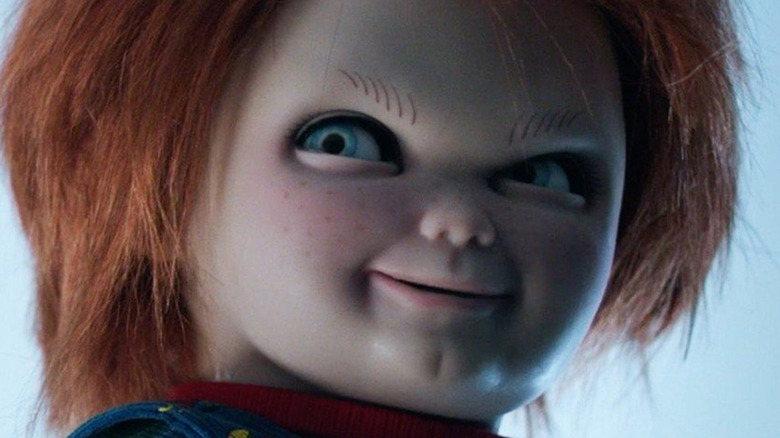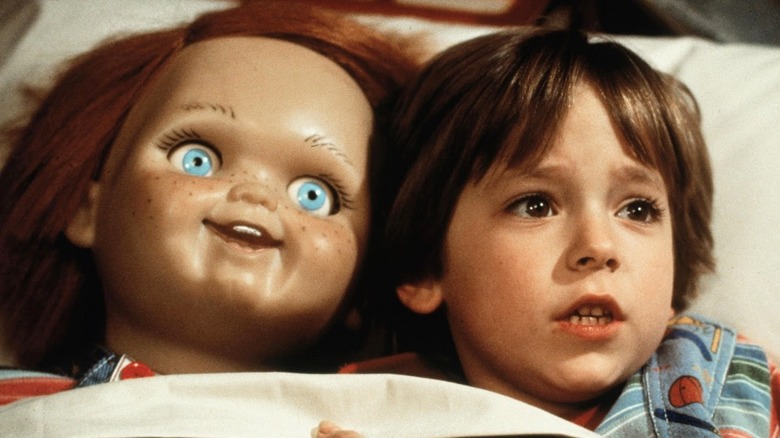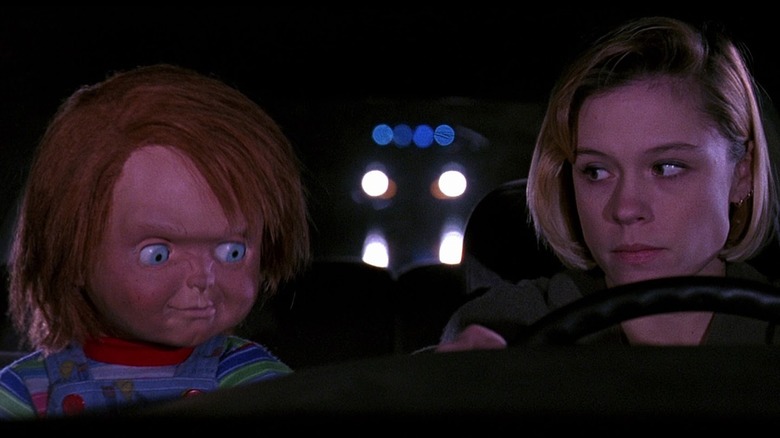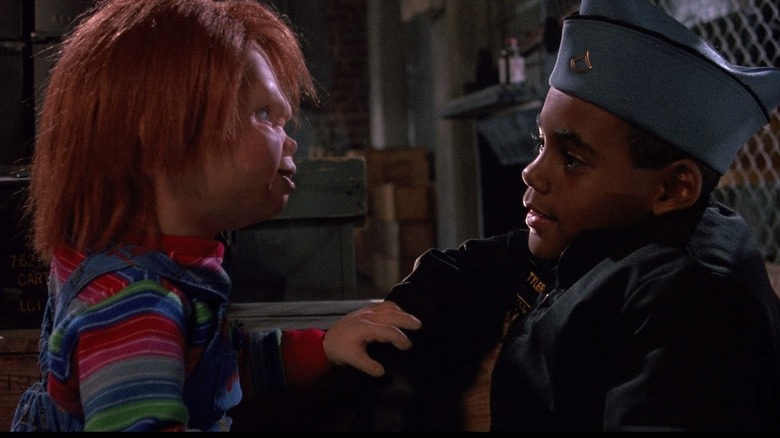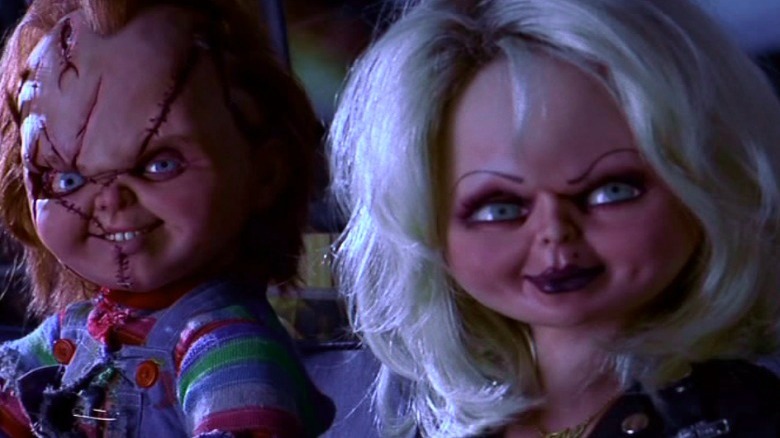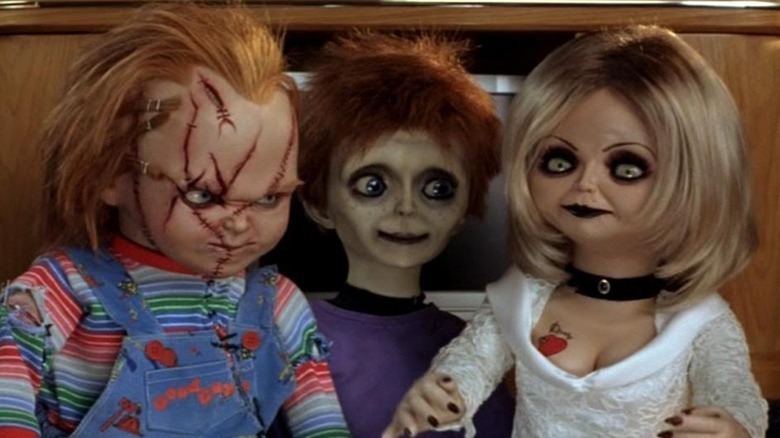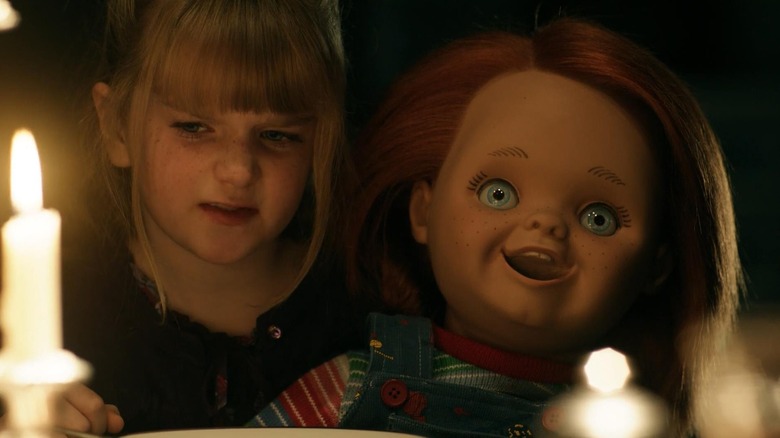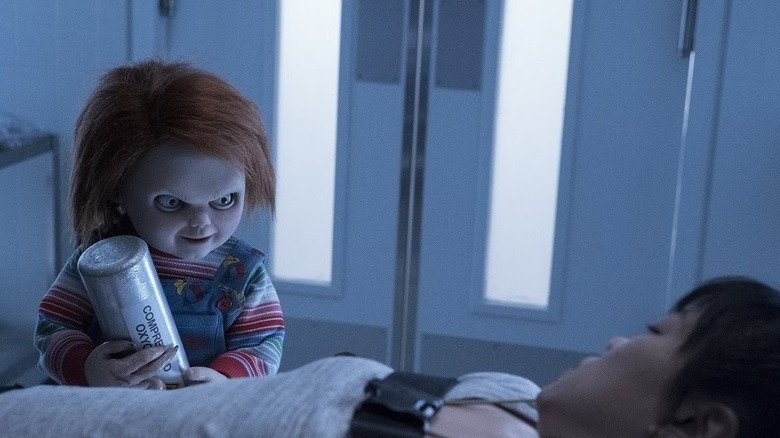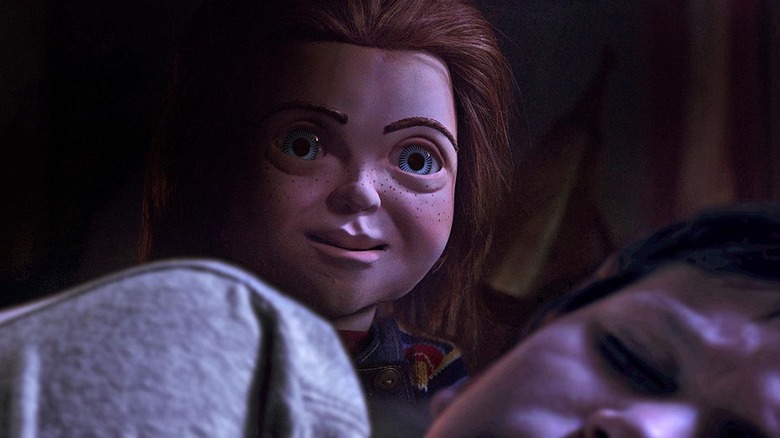This Is The Correct Order In Which To Watch The Chucky Movies
With Syfy's "Chucky" series on the small screen as an official continuation of the original film franchise, fans of the killer doll might be wondering about all of Chucky's killer antics. But with over 30 years and seven films (eight, if you want to check out the reboot) under his overalls, that can be intimidating. Plus, once you get past "Child's Play" 1 through 3, the handy numbering system is thrown out the window as the children become less important and Chucky takes center stage.
Then there's the completely unique vibe of the films as Chucky is constantly reinvented for new eras. Surprisingly, especially for a slasher franchise, the order one watches these murderous doll-centered films really does make a difference. Creator Don Mancini has written every one of Chucky's original seven films, and he's helming the Syfy series as well. As Mancini told Forbes, by the time he made the franchise's fifth installment, he was, indeed, trying to give each film its own special flavor. However, that didn't mean he wanted them to stand alone.
"I wanted the narrative to have a kind of cohesion," he explained. "There's something extra fun about that kind of consistency." There is, believe it or not, a linear story running through everything from the original Andy Barclay era, to the horror-comedies of the '90s, and the back-to-basics films of the modern era. So to catch you up for the new series, here's the official order in which you should watch the "Chucky" movies.
Child's Play (1988)
1988's "Child's Play" is the movie that started it all, so that's where viewers need to begin. Now a lot of horror films begin with a little mystery, as we're never sure at first where the villain comes from or how they came to be. "Child's Play" throws this out and within the film's first seven minutes gives viewers Chucky's origin. A serial killer named Charles Lee Ray (Brad Dourif) is cornered in a toy store by the cops. He's shot, but before he dies, he transfers his soul into the body of a Good Guy doll with a Voodoo ritual. Just like that, we have Chucky, a sociopathic doll who ends up in the arms of 6-year-old Andy Barclay (Alex Vincent).
The first film is more restrained than many that followed, slowly building Chucky's menace and drawing those around Andy like his mom, Karen (Catherine Hicks), and police detective Mike Norris (Chris Sarandon) into the battle. It also establishes the rules for the next few films to follow. Chucky only has a limited time to escape doll life, and can only accomplish that by transferring his soul into the first person he revealed himself to: Andy. Otherwise he'd be trapped as a doll forever, turning more and more human and vulnerable to harm. When Chucky's finally killed (as happens to any good horror villain at least once per movie), it just begins his cycle of death, rebirth, and a desperate struggle to regain his humanity.
Child's Play 2 (1990)
The first "Child's Play" was a bit of a thriller focused more on Andy's mom coming to grips with the realization that her son has a killer doll. By 1990's "Child's Play 2," though, the series had turned into a full-on slasher film, with the increasingly creative kills taking center stage. And as the kills grow more fun, so too does Chucky. He gets a bit more mouthy and wise-cracking, but somehow also more terrifying. He tracks Andy down to a foster home after the poor kid's mom was locked up for insisting a killer doll attacked her son.
This first sequel kicks the series' critique of consumerism and greed into high gear. Chucky's brought back by the toy company that makes the Good Guy dolls, Play Pals Inc. They intentionally rebuild him to somehow reassure the stockholders after all that nasty publicity Andy and Karen gave the company. The result, of course, is predictable to anyone who knows Chucky, but we guess it might not be so obvious to a corporate executive just worried about recovering the bottom line.
Though not quite as strong as the first film, "Child's Play 2" is still a solid entry. Its creative, candy-colored end sequence is one of the most memorable in the series. Plus, it gave fans one of the most beloved heroines of the franchise: Kyle (Christine Elise), Andy's street-tough foster sister, who's his only ally in a world of killer dolls and hostile grown-ups.
Child's Play 3 (1991)
"Child's Play 3" was the last of the original Andy saga, and an odd film. Released in 1991, less than a full year after "Child's Play 2," Chucky's third entry actually jumps forward eight years after the end of the second movie, putting it in 1998. Andy's now a 16-year-old played by Justin Whalen, and Kyle's nowhere in sight. Instead, after being thoroughly traumatized as a child, Andy's been bouncing around foster homes until he's sent off to military camp in the present (future?) day. Play Pals Inc took a bit longer to recover from the bad publicity this time, but they're finally back, and Chucky gets remade again.
This time, the murderous doll terrorizes not just Andy, but the new kid who discovers him, 8-year-old Ronald Tyler (Jeremy Sylvers). Chucky kills his way through the hyper-macho military establishment as he chases the two, though by now, the whole shtick is admittedly wearing a little thin. It's a pretty unnecessary movie, panned by critics and even Chucky fans, and it doesn't really add much to the overall storyline. Even the Andy recast was undone eventually.
"Child's Play" by this time was sputtering out enough that when Chucky was sliced, diced, and killed off once more, he stayed dead for a good seven years. But the third film did accomplish one thing. The eight-year time jump perfectly positioned the next film to bring Chucky back from the dead in a way that would ensure he'd never disappear again.
Bride of Chucky (1998)
Made seven years later, 1998's "Bride of Chucky" takes place just a month after the end of "Child's Play 3." While "Child's Play 3" is very much a leftover of the '80s slasher craze, "Bride" is a self-parodying meta film of the post-"Scream" era (the movie poster is even lifted straight from "Scream 2"). By now, the heroes of the film are inconsequential. Chucky is the star, and this is the movie that embeds him in pop culture.
"Bride" unforgettably introduces us to Chucky's old girlfriend from when he was human, Tiffany, played as sweetly sociopathic by Jennifer Tilly. She steals his remains left over from the third film, stitches him back together, and brings him back with a Voodoo spell she found online. This is the film that starts expanding on the Voodoo powers from the first film, but don't expect a ton of logic. Just enjoy it. It introduces the Heart of Damballa, which frees Chucky up from having to transfer his soul into specific people. Also, apparently, internet Voodoo is a thing, and he can now transfer other people's souls as well.
It's really a twisted rom-com, filtered through "Bride of Frankenstein." Everything from Chucky's new stitched-together look, to Tiffany's eventual rebirth as his monster doll equal harkens back to the classic. Comically bloody mayhem ensues, but before the psycho couple is offed, they manage to squeeze in some twisted doll loving, and the horrifying result sets us up for the next film in the series.
Seed of Chucky (2004)
"Seed of Chucky" continues the self-referential humor of "Bride" and takes it to new levels of bonkers level absurdity. And that's exactly as Don Mancini planned it. As he told NYMag, "When you get these iconic franchise characters — Freddy, Jason, Michael Myers — the more familiar they become, the less scary they are. With Chucky, it's particularly true because, well, he's a doll. It's already absurd. But that distance allows you to experiment."
This film picks up in 2004, six years after "Bride," with Tiffany's monstrous offspring having grown into a doll named Glen (Billy Boyd). Or is it Glenda? Glen struggles with gender dysphoria as he tries to figure out his identity. That dysphoria, though, also comes with a healthy dose of his parents' murderous tendencies, depending on whether he's the sweet Glen or psycho Glenda.
Glen soon revives his doll parents, and Chucky and Tiffany go off on another murder spree, this time in Hollywood. It's an off-the-walls detour, and it doesn't get much more meta than when Tiffany meets Jennifer Tilly. Like "Child's Play 3," it still feels a bit superfluous as we've yet to see Glen/Glenda return since this film. It's also not the most nuanced way to handle gender dysphoria, rendering this over-the-top entry about as polarizing as they come, but by this point in the series, tasteless was pretty much Chucky's M.O. But it does accomplish one thing that resonates down the line, and that's finding a human body for Tiffany.
Curse of Chucky (2013)
It may be tempting to jump into the franchise in the modern era with 2013's "Curse of Chucky," but make no mistake, it does follow the franchise continuity. The film swings away from the antics of Chucky and family to focus on a new heroine, paraplegic Nica Pierce (Fiona Dourif). Atmospheric and claustrophobic, the gothic film traps us in an old house with Nica, her sister's family, and her niece's brand new Good Guy doll.
Chucky gets another makeover, and "Curse" would do just fine as standalone fare, but as the movie goes on, and a number of twists and turns make it clear that it's tightly tied to the first five films. It's also the only movie besides "Bride of Chucky" to flesh out Charles Lee Ray's backstory. Plus, those cameos at the end get every Chucky fan cheering.
As Mancini told IGN, he had originally planned on doing a "Child's Play" remake. He's big on tapping into the zeitgeist of the times and that was (and let's face it, still is) the "in" thing in Hollywood. But the rights to the original "Child's Play" were all jumbled up, so he made a sequel instead. He just turned it into a soft reboot, reinvented Chucky once more, and returned the series to its horror roots. It's also the first in the franchise that wasn't released in theatres, which is a shame, because it's by far one of the best entries.
Cult of Chucky (2017)
2017's "Cult of Chucky" continues the Nica saga, though this time the action moves to an institute for the criminally insane. It turns out "The doll killed my family," isn't a viable defense in court. Actually, Karen Barclay probably could have told her that. It's been four years since their last confrontation, but Chucky finally manages to worm his way into the institute as a "therapeutic" Good Guy doll so that he can finish what he started with Nica.
While it's tricky to explain without getting into some pretty significant and weirdly fun spoilers, the movie revisits Chucky's Voodoo powers in a big way. The old rules, though, are utterly shattered, and "Cult of Chucky" explodes the franchise out into virtually every direction imaginable. It's another claustrophobic journey with creative kills, but this time, Chucky starts clawing his way back to center-stage in a big, big way.
It's a strong, highly entertaining horror jaunt that really ties all the film eras together. It merges the darker horror and suspense of the original "Child's Play" and "Curse of Chucky" with some wackier elements that would fit right in with "Bride of Chucky." It also ties the films together quite literally, with both Andy –- played by original actor Alex Vincent –- and Tiffany stopping by to join Nica on this new Chucky playground. Plus, there's that uncredited Kyle cameo at the end, setting all four characters up to take part in Sy-Fy's new "Chucky" series.
Child's Play reboot (2019)
Though it's not really necessary to watch the 2019 "Child's Play" reboot, as it has nothing to do with the main film franchise, if you're going to marathon it with the others, make sure you view it last. For one thing, it's a very modern take on the consumerism angle that the franchise started out tackling, with a healthy dose of technophobia thrown in for good measure. Instead of a possessed Good Guy doll, Chucky is a malfunctioning, high-tech Buddi doll. It's good to see how the original "Child's Play" tackled '80s consumerism in the era of Cabbage Patch Kids and My Buddy dolls before seeing how that evolved into where we are today.
But maybe, more importantly, watch it last because, honestly, it's a far better movie than a remake has a right to be. The Mancini-verse series deserves the respect to have the remake compared to it, and not the other way around. And Mancini had nothing to do with this one. The original "Child's Play" is the only film owned by United Artists, so they were the ones to handle the reboot. Universal owns the rights to all the other films.
We still get the mother and son duo in Karen and Andy Barclay, plus detective Mike Norris, but everything else is changed from the original. This Chucky doesn't have as much of a personality, but the movie itself certainly does. Plus, the explosive, feverish end sequence alone is worth the viewing.
